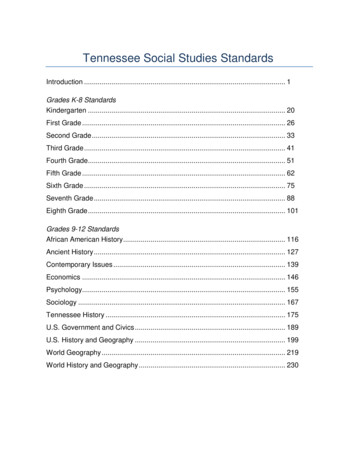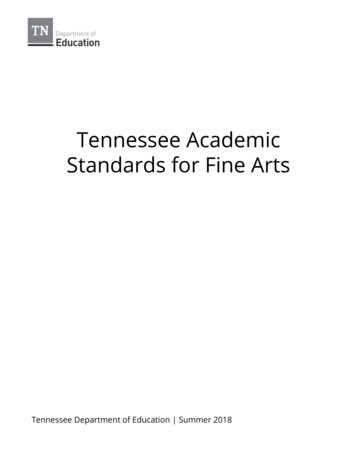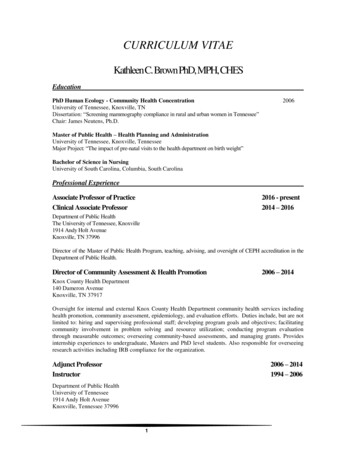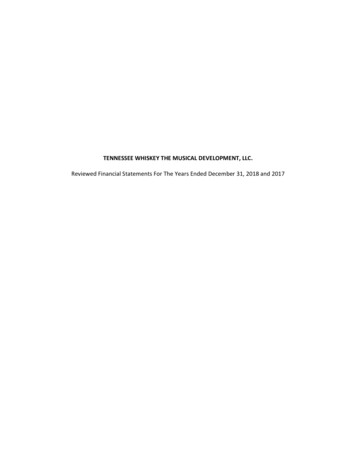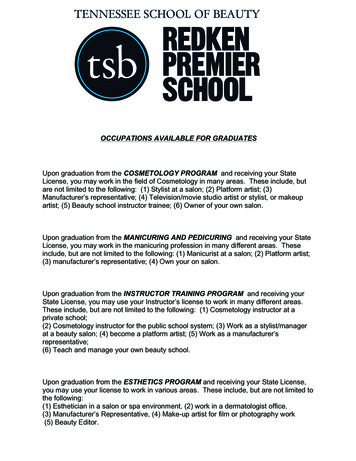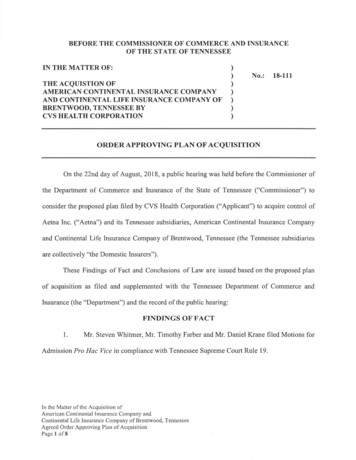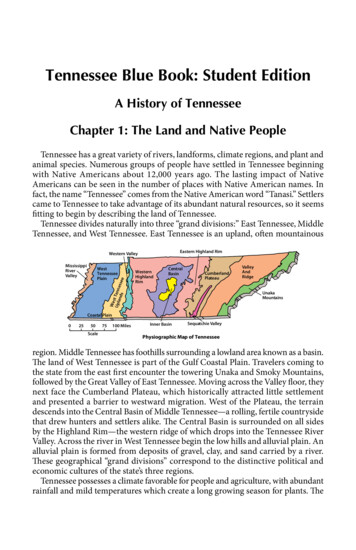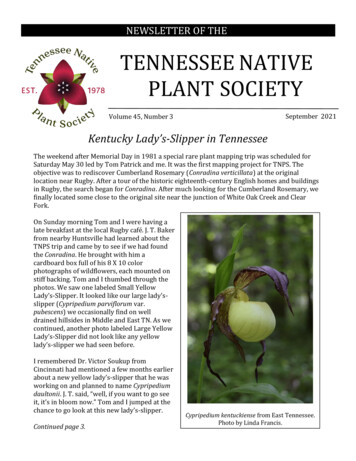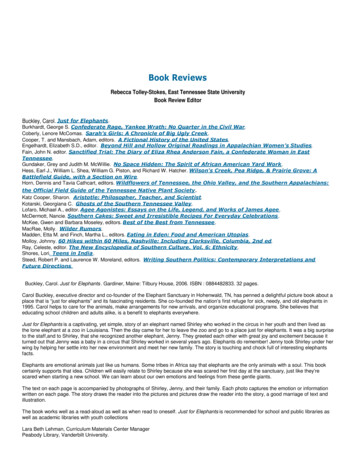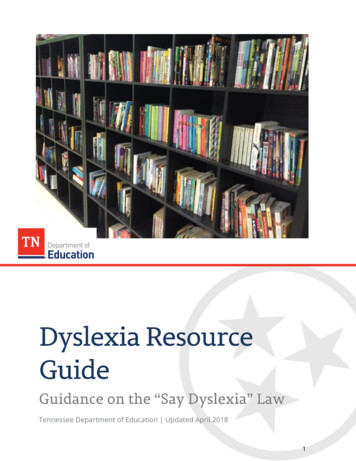
Transcription
Tennessee Department of Education Updated April 20181
Section I: Introduction.4Purpose of the Dyslexia Resource Guide.4Section II: Defining Dyslexia .5What is dyslexia?.5Characteristics of Dyslexia.6Section III: Response to Instruction and Intervention (RTI2) .9Tier I .10Tier II .10Tier III .10Section IV: Dyslexia Screening Procedures.11Section V: School-based Problem Solving Teams .14Section VI: Parent Notification/Communication .14Section VII: Tier I (Core) Instructional Approaches .15Classroom Instructional Context .15Foundational Skills.16Reading/Listening Comprehension .17Vocabulary.17Differentiation.18Section VIII: Dyslexia-Specific Interventions .19Section IX: Progress Monitoring.20Section X: Accommodations.20Section XI: Professional Development Resources .21Section XII: Reporting by School Districts .22Section XIII: Parent-Initiated Dyslexia Evaluations.22Section XIV: Special Education and Dyslexia .23References .25Appendix A: Glossary .26Phonological Awareness Skills Screener (PASS), and Phonics and Word Reading Survey(PWRS) can be found here: .27Appendix B: “Say Dyslexia” Bill (Public Chapter 1058 of the Acts of 2016).282
Appendix C: Dyslexia Advisory Council .32Appendix D: Teacher Observation Questionnaire for Dyslexia .33Appendix E: Example Survey Level Assessments .36Appendix F: Sample Parent Letter.38Appendix G: Differentiation Inventory .40Appendix H: Dyslexia-Specific Intervention Checklist .43Appendix I: Additional Resources.443
Purpose of the Dyslexia Resource GuideThe Dyslexia Resource Guide is provided to assist districts in their implementation of therequirements established by the “Say Dyslexia” law (T.C.A. § 49-1-229). In particular, this guide a)identifies and clarifies the law requirements; and b) defines dyslexia and provides applicableresources.The “Say Dyslexia” law requires the department to develop guidance for identifyingcharacteristics of dyslexia and to provide appropriate professional development resources foreducators in the areas of identification and intervention methods for students with dyslexia. Thislaw also requires the creation of a dyslexia advisory council to advise the department on mattersrelated to dyslexia (See Appendix B). This council is comprised of nine appointed members withthree additional ex officio members. Council membership can be found in Appendix C.The law outlines specific roles and responsibilities for Local Education Agencies (LEAs), theTennessee Department of Education (TDOE), and the appointed Dyslexia Advisory Council. Asummary of the requirements and related roles are detailed below (Table 1).Table 1: “Say Dyslexia” Law Requirements and Related ne s’appropriatestudents’for identifyingproblem-parents andtieredprogresscharacteristicssolving teamprovidedyslexia-using a toolof dyslexiato analyzethem withspecificdesigned tothrough thescreeninginformationinterventionmeasure theuniversaland progressandthrough ng RTIprocessdata.regardingframework.required by2of theintervention.dyslexia.the existingRTI for f dyslexiaresources forthrough theeducators inuniversalthe areas ofscreeningidentificationprocessandrequired byintervention4
AgencyRoles/Responsibilitiesthe existingmethods forRTIstudents with2framework.dyslexia.DyslexiaAdvise theMeet at leastSubmit anAdvisoryTDOE onquarterly.annualCouncilmattersreport torelating toeducationdyslexia.committees.This guide will provide districts with information related to screening procedures for dyslexia,dyslexia-specific intervention, professional development resources, and reportingrequirements. The Dyslexia Resource Guide will be developed and updated with input andfeedback from the Dyslexia Advisory Council and other key stakeholder groups.The “Say Dyslexia” law requires screening for the characteristics of dyslexia in order to provideappropriate interventions; however, it does not refer to the identification or diagnosis ofdyslexia. In order to provide guidance regarding the screening and programming needs forstudents who may display these characteristics, it is important to have an understanding ofdyslexia.What is dyslexia?Dyslexia is a specific learning disability that is neurological in origin and is characterized bydifficulties with accurate and fluent word recognition and by poor spelling and decoding abilities.These difficulties typically result from a deficit in the phonological component of language that isoften unexpected in relation to other cognitive abilities and the provision of effective classroominstruction. Secondary consequences may include problems in reading comprehension and reducedreading experience that can impede growth of vocabulary and background knowledge.1Dyslexia is a language-based condition rather than a vision-based condition. Students withdyslexia struggle with the relationship between letters and sounds. Because of this, they have ahard time decoding, or sounding out, unfamiliar words, and instead often misread them based onan overreliance on their sight-word memory. Deficits are unexpected relative to cognitive abilitiesin that the student’s skills are lower than their overall ability and are not due to a lack ofintelligence.2Screening for characteristics of dyslexia is a proactive way to address skill deficits throughappropriate interventions. Screening results that reflect characteristics of dyslexia do notnecessarily mean that a student has dyslexia nor can dyslexia be diagnosed through a1International Dyslexia Association (2002). nal Dyslexia Association https://dyslexiaida.org/dyslexia-basics/5
screening alone.Characteristics of DyslexiaPer the “Say Dyslexia” law, dyslexia screening procedures shall include the followingcharacteristics of dyslexia*: Phonological awareness: a broad category comprising a range of understandingsrelated to the sounds of words and word parts; Phonemic awareness: the ability to notice, think about, and work with the individualsounds in spoken words; Alphabet knowledge: understanding that letters represent sounds, which form words;Sound/symbol recognition: understanding that there is a predictable relationshipbetween phonemes (sounds in spoken language) and graphemes (the letters thatrepresent those sounds); Decoding skills: using knowledge of letters and sounds to recognize and analyze aprinted word to connect it to the spoken word it represents (also referred to as “wordattack skills”); Encoding skills: translating speech into writing (spelling); and Rapid naming: ability to connect visual and verbal information by giving theappropriate names to common objects, colors, letters, and digits (quickly namingwhat is seen). Rapid naming requires the retrieval of phonological informationrelated to phonemes (letter/ letter combination sounds), segments of words, andwords from long-term memory in an efficient manner. This is important whendecoding words, encoding words, and reading sight words.*See an additional breakdown of skills in the glossary found in Appendix A.Students with dyslexia share some common characteristics, but it is important to rememberthat it manifests differently depending on the individual, their age, and other factors affectinghis/her foundational reading skill development. In addition, students may have co-occurringdisabilities/disorders, including twice exceptionality (i.e., gifted and dyslexia). Comorbidsymptoms may mask characteristics of dyslexia (e.g., inattention and behavioral issues aremore apparent or gifted students may compensate well); on the other hand, a student’sdisability may impair participation in grade-level instruction, creating deficits that may bemisinterpreted as characteristics of dyslexia.6
Table 2: Common Characteristics of Dyslexia3Age GroupDifficultiesGrades K–1 StrengthsReading errors exhibit no connection The ability to figure things outto the sounds of the letters on the Eager embrace of new ideaspage (e.g., will say “puppy” instead of Gets “the gist” of thingsthe written word “dog” on an A good understanding of newillustrated page with a dog shown) Does not understand that wordsconcepts come apart Complains about how hard reading is,A large vocabulary for the agegroup Excellent comprehension of storiesor “disappears” when it is time toread aloud (i.e., listeningreadcomprehension) A familial history of reading problems Cannot sound out simple words likecat, map, nap Does not associate letters withsounds, such as the letter b with the“b” soundGrades 2 Very slow to acquire reading skills;Excellent thinking skills:reading is slow and awkwardconceptualization, reasoning,Trouble reading unfamiliar words,imagination, abstractionoften making wild guesses because Learning that is accomplished besthe cannot sound out the wordthrough meaning rather than roteDoesn’t seem to have a strategy formemorizationreading new words Ability to get the “big picture” Avoids reading out loud A high level of understanding of Confuses words that sound alike,what is read aloud (listeningsuch as saying “tornado” forcomprehension)“volcano,” substituting “lotion” for The ability to read and to“ocean”understand highly practiced wordsMispronunciation of long, unfamiliar,in a special area of interestor complicated words Sophisticated listening vocabularyAvoidance of reading; gaps in Excellence in areas not dependentvocabulary as a resulton readingEvery child is unique, and therefore the rate of development may vary. It is possible that a child maynot reach a developmental milestone until the upper end of the expected range. Concerns are3Taken from The Yale Center for Dyslexia and Creativity, Signs of Dyslexia.http://dyslexia.yale.edu/EDU signs.html7
warranted, however, if the behaviors occur over an extended period of time and adversely affectthe child’s ability to progress and meet expectations. Many young children reverse letters andnumbers, misread words or misunderstand words as a normal, developmental part of learning toread. Children with dyslexia, however, continue to do so after their peers have stopped.4 This is oneof many misconceptions that surround the term “dyslexia.” Below are more of the myths and truthsassociated with dyslexia.Table 3: Common MythsTruth: Many children reverse their lettersReversalsMyth: Dyslexia is a visual problem.when learning to read and write.Students with dyslexia see and writeReversing letters is not a sure sign ofletters and words backwards.dyslexia, and not all students withdyslexia reverse letters.1Truth: Some students with dyslexiaSchool SuccessMyth: If you perform well in school,you must not have dyslexia.perform well in school. These studentswork hard, are motivated, and have theaccommodations necessary to showtheir knowledge.1Truth: Dyslexia is defined by anIntelligenceMyth: Smart students cannot beunexpected difficulty in learning to read.dyslexic; students with dyslexiaSaid another way, dyslexia is a paradox—cannot be very smart.the same person who struggles to readquickly often has very high intelligence.1Truth: Most students with dyslexia doReading AbilityMyth: Students with dyslexia cannotlearn to read.learn to read, but with greater effort.They tend to remain “manual” ratherthan “fluent” readers, reading slowly andwith great effort.1Truth: The hallmark of dyslexia is anunexpected reading difficulty in a childwho seems to have all the equipment(intelligence, verbal skills, motivation)ReadingMyth: All reading difficulties can benecessary to become a reader.1 ThereDifficultiesattributed to dyslexia.are other ways students can struggle toread: (1) 3–10 percent of students whoare strong decoders don’t understandwhat they are reading (specific readingcomprehension deficit),3 and (2) some4 Harvard Medical School ones/dyslexia 8
students struggle with both the code ofthe language and the meaning oflanguage (mixed reading deficit).Truth: Dyslexia comes in many degreesfrom mild to severe.2 Some children withdyslexic characteristics meet therequirements for TN SLD eligibility andEligibilityMyth: If a student has dyslexia, theysome do not. All students receivewill have an IEP. An IEP is the only wayappropriate, differentiated instructionto get the appropriate instruction andand universal accommodations in Tier 1,accommodations needed.and when needed, the student mayreceive Tier II or Tier III intervention.Students who do not respond to theseinterventions may be eligible to receiveinterventions through special education.Truth: Students of both genders canGenderMyth: Only boys are affected byhave dyslexia. The higher number ofdyslexia.male referrals may be due to differencesin classroom behaviors.1Short-termMyth: Most students will eventuallyProblemoutgrow dyslexia.Truth: Dyslexia is the result of aprocessing difference in the brain andwill last a lifetime.1Truth: Students with dyslexia tend tohave strong comprehension skills, butthis can be masked by (1) the amount ofComprehensionMyth: Students who have dyslexiamental effort required to decode,have poor reading comprehensionlimiting access to the ability to thinkskills.critically, and (2) a limited amount ofreading, leading to a gap in the student’svocabulary as compared to students whoread large amounts of appropriate text.1Response to Instruction and Intervention (RTI²) is a framework designed to meet the needsof all students through increasingly intensive interventions. With RTI², all students receivecore instruction; some students may need more targeted support in addition to this core9
instruction through Tier II interventions; and a few students may need more intensivesupport in addition to core instruction through Tier III interventions. As outlined in PublicChapter 1058 districts must identify characteristics of dyslexia through their existing RTI²universal screening process and provide appropriate tiered dyslexia-specific interventionsfor students identified with these characteristics.Tier ITier I instruction, also known as core instruction, provides rich learning opportunities for allstudents that are aligned to the Tennessee academic standards and are responsive to studentstrengths and needs through differentiation. The entire range of learners, including thoseidentified with disabilities, students with the characteristics of dyslexia, students who areidentified as gifted, and English learners, are included and actively participate in Tier I instruction.Differentiation, based on multiple sources of data, is a hallmark of Tier I (see Component 2 of theRTI² manual).Tier IITier II addresses the needs of struggling and advanced students. Those students who requireassistance beyond the usual time allotted for core instruction should receive additional skillbased group intervention daily aligned to the specific area of need. Tier II intervention is explicitand systematic. Advanced students should receive reinforcement and enrichment. Interventionincludes explicit instruction within the area of need for all struggling students. For example,students with the characteristics of dyslexia should receive interventions that address thespecific phonological deficits identified through targeted assessments (see Section VIII: DyslexiaSpecific Interventions and Component 3 of the RTI² manual).Tier IIITier III is in addition to the instruction provided in Tier I. Tier III addresses 3–5 percent of studentswho have received Tier I instruction and Tier II interventions and continue to show markeddifficulty in acquiring necessary reading, mathematics, and writing skills. It could also includestudents who score below a designated cut score on the universal screening. These cut scoresshould be based on national norms that identify students who are at risk. As a guideline, studentsbelow 10th percentile would be considered the most "at risk" and in possible need of Tier IIIintervention. When teachers and school-level RTI² support teams are making placement decisionsfor Tier III interventions, it may be necessary to consider other assessments, data, andinformation on the student. Such examples may include attendance records, past retention, orperformance on TCAP. Students at this level should receive daily, intensive, small group, orindividual intervention targeting specific area(s) of deficit, which are more intense thaninterventions received in Tier II. Intensity can be increased through length, frequency, andduration of implementation. A problem-solving approach within an RTI2 model is highlyrecommended so that the data team can tailor an intervention to an individual student. It typicallyhas four stages: problem identification, analysis of problem, intervention planning, and responseto intervention evaluation. Intervention includes explicit instruction within the area of need for all10
struggling students. For example, students with the characteristics of dyslexia shall receiveinterventions that address the specific phonological deficits identified through targetedassessments (see Section VIII: Dyslexia-Specific Interventions and Component 4 of the RTI²manual).If a student is not successful with interventions provided through general education (i.e., RTI²),s/he may be referred for evaluation to consider eligibility for special education as this mayindicate a possible specific learning disability (see Section XIV: Special Education and Dyslexia).Per current legislation, Public Chapter No.1058, the Tennessee Department of Education shalldevelop procedures for identifying characteristics of dyslexia through the universal screeningprocess required by the existing RTl2 framework or other available means.The requirement that districts must implement RTI² has resulted in districts establishing auniversal screening process that best meets the needs of their students. Districts shouldimplement a universal screening process that uses multiple sources of data to identify individualstudent strengths and areas of need and that provides them with accurate information formaking informed decisions about skills-specific interventions, remediation, reteaching, andenrichment for each child. All students must participate in a universal screening process toidentify those who may need additional support and/or other types of instruction.The universal screening process also plays an important role in fulfilling the requirements ofTennessee’s dyslexia legislation (Public Chapter 1058 of the Acts of 2016). Passed during the2016 legislative session, this law requires that districts implement a screening process foridentifying characteristics of dyslexia.Districts with an appropriate, effective universal screening process in place will be able to usethe information they collect to make important determinations about dyslexia-specificaccommodations and interventions.The universal screening process involves three steps:Step One:In grades K– 8, districts should administer a nationally normed, skills-based universal screeneras part of the universal screening process. Universal screeners are not assessments in thetraditional sense. They are brief, informative tools used to measure academic skills in six generalareas (i.e., basic reading skills, reading fluency, reading comprehension, math calculation, mathproblem solving, and written expression).If a standards-based assessment is used to screen all students instead of a skills-baseduniversal screener, a skills-based screener is still necessary to identify more specific skillarea(s) of focus and to determine alignment of interventions for students identified as “atrisk.”11
A skills-based universal screener is the most appropriate, defensible tool for identifying studentsthat have skills deficits and informing the need for a skills-based intervention. If a skills-baseduniversal screener is not used, districts might not identify students with underlying skills deficits orproperly align interventions. Further, if districts do not use a skills-based universal screener and areunable to collect accurate data associated with a suspected area of disability, they may run the risk ofviolating their Child Find obligation.When considering characteristics of dyslexia, screening in the areas of basic reading, readingfluency, and written expression help identify students who may need additional assessment todetermine possible deficits related to the characteristics of dyslexia and the need for intervention.These areas are outlined below.Table 4: Assessment AreasAssessment areaDefinitionMeasuresBasic ReadingPhonemic awareness, sightK–1 measures include letterword recognition, phonics,and sound identification,and word analysissegmentation, and blendingEssential skills includeskillsidentification of individualGrades 1 include accuracy ofsounds and the ability toword reading/ decodingmanipulate them;within text (i.e. correct wordsidentification of printed letterspercentage)and sounds associated withletters; and decoding ofwritten language.Reading FluencyThe ability to read wordsGrades 1 : Curriculum-basedaccurately, using age-oral reading fluency measuresappropriate chunkingstrategies of syllables andphrases and a repertoire ofsight words and withappropriate rate, phrasing,and expression (prosody)Written ExpressionCommunication of ideas,Grades 2 : Curriculum-basedthoughts, and feelingsmeasures of writingRequired skills include usingmeasuring correct wordoral language, thought,sequences and spellinggrammar, text fluency,sentence construction, andplanning to produce a writtenproduct. Spelling often affects12
Assessment areaDefinitionMeasureswritten products. This is not ameasure of handwriting.In grades 9–12, schools should collect multiple sources of data that can be incorporated into anearly warning system (EWS). The EWS may include data from universal screeners, achievementtests (from both high school and grades K–8), end of course (EOC) exams, student records (e.g.,grades, behavioral incidents, attendance, retention, past RTI2 interventions), the TennesseeValue-Added Assessment System (TVAAS), and the ACT/SAT exam or other nationally normedassessments. (A template can be found on the TDOE RTI² Instructional Resources webpage)Districts will establish criteria for identifying students who are at risk using this EWS bydetermining appropriate thresholds for each indicator (e.g., Missing ten percent of instructionaldays may be a flag for attendance.) and weighting each indicator appropriately based on localcontext.Step Two:In grades K–12, school teams should consider the results of the skills-based universal screeneror EWS compared to other classroom-based assessments. These may include but are notlimited to: standards-based assessments, grades, formative assessments, summativeassessments, classroom performance, and teacher observations, in addition to any otherrelevant information such as medical or family history. This information should be used tocorroborate performance on the skills-based universal screener. School teams should alsoconsider sources that measure early risk factors or indicators of dyslexia. See Appendix D for anexample checklist.The school team should also consider a parent’s request for additional screenings if there areconcerns beyond the results of the universal screening process. (Refer to Section XII for additionalinformation regarding parent requests.)Step Three:In grades K–12, students identified as “at risk” based on multiple sources of data should beadministered survey-level and/or diagnostic assessments to determine student intervention needs.As required by the “Say Dyslexia” law (T.C.A. § 49-1-229), these survey-level assessments for readingmust explicitly measure characteristics of dyslexia to include: phonological and phonemicawareness, sound symbol recognition, alphabet knowledge, decoding skills, rapid naming, andencoding skills.Example survey-level assessments that can be used to help drill down further to measurecharacteristics of dyslexia can be found in Appendix E.13
Figure 1 Universal Screening ProcessStep One Screen all students using a skills-based screener. If a standards-based assessment is used to screen all students instead of skillsbased universal screener, a skills-based screener is necessary to identify morespecific skill area(s). Consider additional sources of information to identify "at-risk" students.Step Two Conduct survey-level diagnostic assessments to inform intervention needs.Step ThreeMore information regarding the universal screening process can be found in the RTI2 manual(here) under component 1.3.As part of the existing data-based decision-making process within the RTI2 framework, schoolbased teams shall meet to review and analyze data obtained through the universal screeningprocess, including data found through survey level assessments. Using multiple sources of data,the team will discuss, plan, and determine appropriate evidenced-based tiered instruction andinterventions for students with skill deficits including deficits associated with the characteristicsof dyslexia.Teams may suggest ways to meet student needs such as classroom accommodations and usageof assistive technology. Appropriate professionals with specific skill sets may be needed to assistin decision making for interventions, accommodations, and the use of assistive technology (e.g.,school psychologist, speech language pathologist, occupational therapist, reading specialist,school counselor, etc.). Teams may refer students for additional considerations whenappropriate such as a 504 plan or special education evaluation if additional accommodations orspecialized instruction beyond tiered interventions are required to the meet the student’s needs.After a school-based team has reviewed multiple sources of data in the screening process andidentified skill deficits in need of intervention, parents shall receive notification of the student’sperformance and need for intervention. The notification should include specific areas of deficits14
associated with the characteristics of dyslexia. For example, if a student demonstratesweaknesses in phonological awareness inconsistent with developmental expectations andrequires interventions, the parent notification should identify the area of weakness targ
Purpose of the Dyslexia Resource Guide . The Dyslexia Resource Guide is provided to assist districts in their implementation of the requirements established by the "Say Dyslexia" law (T.C.A. § 49-1-229). In particular, this guide a) identifies and clarifies the law requirements; and b) defines dyslexia and provides applicable resources.
